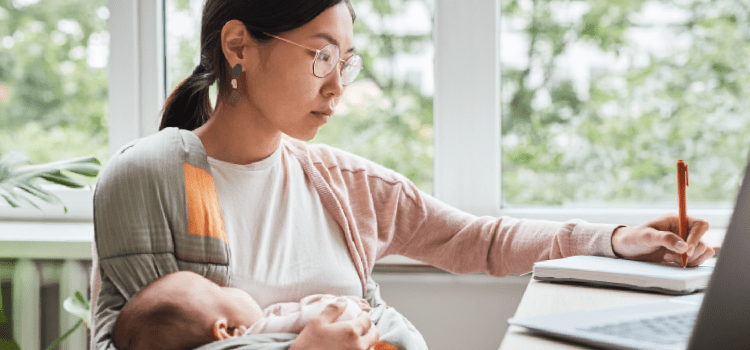Whether you’re expecting the pitter-patter of tiny feet or you’ve just brought your new bundle of joy into the world, congratulations!
If you’re in employment and on maternity leave, you will likely be receiving Statutory Maternity Pay (SMP) if you are a qualifying employee.
To qualify, you must:
- Have been working for your employer for at least 26 weeks by the 15th week prior to your baby’s due date
- Earn a minimum of £123 per week (pre-tax)
- Have given notice to your employer at least 28 days before stopping work
- Have provided proof of the pregnancy (typically this is a MATB1 form you can get from a doctor or midwife)
How much is Statutory Maternity Pay?
SMP is given at 90% of your average weekly earnings (pre-tax) for the first 6 weeks of maternity leave and £172.48 per week for the remaining 33 weeks (or still at 90% of your average weekly earnings if it’s less than £172.48).
For some new parents, freelancing while on maternity leave is a way to earn more money to top up SMP payments. Especially given that employees can take up to 52 weeks of maternity leave but SMP will only be paid for the first 39 weeks.
Self-employment allows for more financial freedom and flexibility if you do want to take the full maternity leave period of 52 weeks but can’t afford the additional 13 weeks with no SMP.
Can I freelance while on maternity if I’m employed?
If you’re on maternity leave from your job and considering freelancing at the same time, there are some important things to know.
- The first key thing to be aware of is compulsory maternity leave.
This legally prohibits anyone from doing any kind of work for two weeks after they give birth. You’ll probably want to spend those two weeks cuddling and adjusting anyway but this legal requirement is worth noting.
After that two-week compulsory maternity leave period, you can start freelancing if you like. You should consult your employment contract first to make sure your employer doesn’t prohibit freelancing while working for them (and then decide what you want to do with that knowledge).
Even when you’re on maternity leave, you’re still legally bound by all the rules and regulations in your employment contract, so you will need to continue complying with them.
Will freelancing affect maternity benefits?
If there’s no clause in your employment contract and you’re permitted to freelance while on maternity leave from your job, your Statutory Maternity Pay shouldn’t be affected.
In this case, self-employment won’t stand in the way of your SMP and you will still receive these payments along with any earnings you make through freelance work.
For the sake of clarity, it’s important to note that if you carry out any work for your employer while you’re on official maternity leave, this will stop your Statutory Maternity Pay. This includes working for your employer on a ‘freelance’ basis for the period of time you’re on maternity leave.
Some new parents think this is a crafty loophole to earn more without having to find or service new clients but this is extremely risky. If you were to be found out, you could lose your maternity benefits, have to pay extra tax to HMRC, and end up out of pocket.
Maternity Allowance and KIT days
Unlike employed people, self-employed freelancers are not entitled to the regular SMP but they can apply for a Maternity Allowance (MA) instead although you can’t have both at the same time.
Even if you start freelancing while on maternity leave, if you’re already getting Statutory Maternity Pay through your employer, you can’t also have the Maternity Allowance.
With the Maternity Allowance, it’s also important to be aware of ‘Keeping in Touch’ (KIT) days. These days allow you to work for a maximum period of 10 days within the time you’re receiving MA and no more. If you work beyond the 10-day threshold, you will lose your entitlement to MA.
Do I have to pay tax on my freelance earnings?
When you’re juggling a new baby and freelance work, you’re certainly going to have a lot on your plate. It’s essential that you still make time to track your income and register for Self Assessment once you go over the tax-free trading allowance.
The trading allowance is the amount of income you can make in a tax year from casual and/or miscellaneous means before starting to pay tax on those earnings. The current threshold is set at a maximum of £1,000 per tax year, and doesn’t apply to the wages you get from your employer.
So, if you make more than £1,000 through your freelance work in a tax year, you’ll need to submit a Self Assessment tax return and pay tax on the earnings over the trading allowance threshold.
You will still be taxed as normal for your employment earnings through your employer’s payroll system. Registering for Self Assessment just means you can pay tax on the extra you make through self-employment.
And no, your employer won’t know unless you tell them, or unless you ask HMRC to collect any tax you owe through your tax code.
Track earnings and expenses with good bookkeeping software
The best way to keep track of your freelance earnings and expenses is by using bookkeeping software. This means you can access your accounts from anywhere with an internet connection and track things like spending and invoices on the go.
If you do start earning more than the trading allowance, bookkeeping software makes it far simpler to figure out how much of your income will then be taxable.
If you hire an accountant to do your Self Assessment tax return for you, bookkeeping software also makes providing them with all the information they need much easier.
Plus, with good bookkeeping practices, an accountant will also be able to help you freelance as tax-efficiently as possible and claim as much tax relief as you can.
Find even more advice and guidance for freelancers in our info hub!







